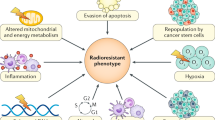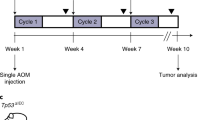Abstract
Proton radiotherapy is becoming more common as protons induce more precise DNA damage at the tumor site with reduced side effects to adjacent normal tissues. However, the long-term biological effects of proton irradiation in cancer initiation compared with conventional photon irradiation are poorly characterized. In this study, using a human familial adenomatous polyposis syndrome susceptible mouse model, we show that whole-body irradiation with protons are more effective in inducing senescence-associated inflammatory responses (SIRs), which are involved in colon cancer initiation and progression. After proton irradiation, a subset of SIR genes (Troy, Sox17, Opg, Faim2, Lpo, Tlr2 and Ptges) and a gene known to be involved in invasiveness (Plat), along with the senescence-associated gene (P19Arf), are markedly increased. Following these changes, loss of Casein kinase Iα and induction of chronic DNA damage and TP53 mutations are increased compared with X-ray irradiation. Proton irradiation also increases the number of colonic polyps, carcinomas and invasive adenocarcinomas. Pretreatment with the non-steroidal anti-inflammatory drug, 2-cyano-3,12-dioxooleana-1,9(11)-dien-28-oic acid–ethyl amide (CDDO-EA), reduces proton irradiation-associated SIR and tumorigenesis. Thus exposure to proton irradiation elicits significant changes in colorectal cancer initiation and progression that can be mitigated using CDDO-EA.
This is a preview of subscription content, access via your institution
Access options
Subscribe to this journal
Receive 50 print issues and online access
$259.00 per year
only $5.18 per issue
Buy this article
- Purchase on Springer Link
- Instant access to full article PDF
Prices may be subject to local taxes which are calculated during checkout








Similar content being viewed by others
References
Verhey LJ, Munzenrider JE . Proton beam therapy. Annu Rev Biophys Bioeng 1982; 11: 331–357.
Suit HD, Goitein M, Tepper J, Koehler AM, Schmidt RA, Schneider R . Explorotory study of proton radiation therapy using large field techniques and fractionated dose schedules. Cancer 1975; 35: 1646–1657.
D'angio GJ, Lawrence JH . Medical research with high-energy heavy particles. Nucleonics 1963; 21: 56–61.
Lawrence JH, Tobias CA, Born JL, Linfoot JA, Kling RP, Gottschalk A . Alpha and proton heavy particles and the Bragg peak in therapy. Trans Am Clin Climatol Assoc 1964; 75: 111–116.
Moravek Z, Bogner L . Analysis of the physical interactions of therapeutic proton beams in water with the use of Geant4 Monte Carlo calculations. Z Med Phys 2009; 19: 174–181.
Dicello JF . How do we get from cell and animal data to risks for humans from space radiations? J Radiat Res 2002; 43(Suppl): S1–S6.
Williams JR, Zhang Y, Zhou H, Osman M, Cha D, Kavet R et al. Predicting cancer rates in astronauts from animal carcinogenesis studies and cellular markers. Mutat Res 1999; 6: 255–269.
George K, Durante M, Willingham V, Wu H, Yang TC, Cucinotta FA . Biological effectiveness of accelerated particles for the induction of chromosome damage measured in metaphase and interphase human lymphocytes. Radiat Res 2003; 160: 425–435.
Rithidech KN, Honikel LM, Reungpatthanaphong P, Tungjai M, Golightly M, Whorton EB . Effects of 100MeV protons delivered at 0.5 or 1cGy/min on the in vivo induction of early and delayed chromosomal damage. Mutat Res 2013; 756: 127–140.
Vogelstein B, Kinzler KW . Cancer genes and the pathways they control. Nat Med 2004; 10: 789–799.
Van Dyke T, Jacks T . Cancer modeling in the modern era: progress and challenges. Cell 2002; 108: 135–144.
Fearon ER, Vogelstein B . A genetic model for colorectal tumorigenesis. Cell 1990; 61: 759–767.
Arnold CN, Goel A, Blum HE, Boland CR . Molecular pathogenesis of colorectal cancer: implications for molecular diagnosis. Cancer 2005; 104: 2035–2047.
Su LK, Kinzler KW, Vogelstein B, Preisinger AC, Moser AR, Luongo C et al. Multiple intestinal neoplasia caused by a mutation in the murine homolog of the APC gene. Science 1992; 256: 668–670.
Hinoi T, Akyol A, Theisen BK, Ferguson DO, Greenson JK, Williams BO et al. Mouse model of colonic adenoma-carcinoma progression based on somatic Apc inactivation. Cancer Res 2007; 67: 9721–9730.
Coppe JP, Patil CK, Rodier F, Sun Y, Munoz DP, Goldstein J et al. Senescence-associated secretory phenotypes reveal cell-nonautonomous functions of oncogenic RAS and the p53 tumor suppressor. PLoS Biol 2008; 6: 2853–2868.
Pribluda A, Elyada E, Wiener Z, Hamza H, Goldstein RE, Biton M et al. A senescence-inflammatory switch from cancer-inhibitory to cancer-promoting mechanism. Cancer Cell 2013; 24: 242–256.
Bartkova J, Rezaei N, Liontos M, Karakaidos P, Kletsas D, Issaeva N et al. Oncogene-induced senescence is part of the tumorigenesis barrier imposed by DNA damage checkpoints. Nature 2006; 444: 633–637.
Coppe JP, Desprez PY, Krtolica A, Campisi J . The senescence-associated secretory phenotype: the dark side of tumor suppression. Annu Rev Pathol 2010; 5: 99–118.
Elyada E, Pribluda A, Goldstein RE, Morgenstern Y, Brachya G, Cojocaru G et al. CKIalpha ablation highlights a critical role for p53 in invasiveness control. Nature 2011; 470: 409–413.
Kim SB, Zhang L, Barron S, Shay JW . Inhibition of microRNA-31-5p protects human colonic epithelial cells against ionizing radiation. Life Sci Space Res 2014; 1: 67–73.
Kim SB, Pandita RK, Eskiocak U, Ly P, Kaisani A, Kumar R et al. Targeting of Nrf2 induces DNA damage signaling and protects colonic epithelial cells from ionizing radiation. Proc Natl Acad Sci USA 2012; 109: E2949–E2955.
Kim SB, Ly P, Kaisani A, Zhang L, Wright WE, Shay JW . Mitigation of radiation-induced damage by targeting EGFR in noncancerous human epithelial cells. Radiat Res 2013; 180: 259–267.
Kim SB, Lu Z, Shay JW . Oxygen and silicon ion particles induce neoplastic transformation in human colonic epithelial cells. Gravit Space Res 2014; 2: 32–41.
Eskiocak U, Kim SB, Roig AI, Kitten E, Batten K, Cornelius C et al. CDDO-Me protects against space radiation-induced transformation of human colon epithelial cells. Radiat Res 2010; 174: 27–36.
Kudo S . Endoscopic mucosal resection of flat and depressed types of early colorectal cancer. Endoscopy 1993; 25: 455–461.
Bahnassy AA, Zekri AR, El-Houssini S, El-Shehaby AM, Mahmoud MR, Abdallah S et al. Cyclin A and cyclin D1 as significant prognostic markers in colorectal cancer patients. BMC Gastroenterol 2004; 4: 22.
Miyaoka Y, Chan AH, Judge LM, Yoo J, Huang M, Nguyen TD et al. Isolation of single-base genome-edited human iPS cells without antibiotic selection. Nat Methods 2014; 11: 291–293.
Simone CB 2nd, Rengan R . The use of proton therapy in the treatment of lung cancers. Cancer J 2014; 20: 427–432.
Ahn PH, Lukens JN, Teo BK, Kirk M, Lin A . The use of proton therapy in the treatment of head and neck cancers. Cancer J 2014; 20: 421–426.
Pugh TJ, Lee AK . Proton beam therapy for the treatment of prostate cancer. Cancer J 2014; 20: 415–420.
Keole S, Ashman JB, Daniels TB . Proton therapy for sarcomas. Cancer J 2014; 20: 409–414.
Eaton BR, Yock T . The use of proton therapy in the treatment of benign or low-grade pediatric brain tumors. Cancer J 2014; 20: 403–408.
Hall EJ, Giaccia AJ . Radiobiology for the Radiologist. Lippincott Williams & Wilkins: Philadelphia, PA, USA, 2006.
Parsons JL, Townsend LW . Interplanetary crew dose rates for the August 1972 solar particle event. Radiat Res 2000; 153: 729–733.
Townsend LW, Shinn JL, Wilson JW . Interplanetary crew exposure estimates for the August 1972 and October 1989 solar particle events. Radiat Res 1991; 126: 108–110.
Collis SJ, Schwaninger JM, Ntambi AJ, Keller TW, Nelson WG, Dillehay LE et al. Evasion of early cellular response mechanisms following low level radiation-induced DNA damage. J Biol Chem 2004; 279: 49624–49632.
Breuer H, Smit BJ . Proton Therapy and Radiosurgery. Springer Science & Business Media: New York, NY, USA, 2013.
Wilson JW, Cucinotta FA, Shinn JL, Simonsen LC, Dubey RR, Jordan WR et al. Shielding from solar particle event exposures in deep space. Radiat Meas 1999; 30: 361–382.
Hellweg CE, Baumstark-Khan C . Getting ready for the manned mission to Mars: the astronauts' risk from space radiation. Naturwissenschaften 2007; 94: 517–526.
Delgado O, Batten KG, Richardson JA, Xie XJ, Gazdar AF, Kaisani AA et al. Radiation-enhanced lung cancer progression in a transgenic mouse model of lung cancer is predictive of outcomes in human lung and breast cancer. Clin Cancer Res 2014; 20: 1610–1622.
Reisman SA, Lee CY, Meyer CJ, Proksch JW, Sonis ST, Ward KW . Topical application of the synthetic triterpenoid RTA 408 protects mice from radiation-induced dermatitis. Radiat Res 2014; 181: 512–520.
Thimmulappa RK, Fuchs RJ, Malhotra D, Scollick C, Traore K, Bream JH et al. Preclinical evaluation of targeting the Nrf2 pathway by triterpenoids (CDDO-Im and CDDO-Me) for protection from LPS-induced inflammatory response and reactive oxygen species in human peripheral blood mononuclear cells and neutrophils. Antioxid Redox Signal 2007; 9: 1963–1970.
Petronelli A, Pannitteri G, Testa U . Triterpenoids as new promising anticancer drugs. Anticancer Drugs 2009; 20: 880–892.
Vannini N, Lorusso G, Cammarota R, Barberis M, Noonan DM, Sporn MB et al. The synthetic oleanane triterpenoid, CDDO-methyl ester, is a potent antiangiogenic agent. Mol Cancer Ther 2007; 6(12 pt 1): 3139–3146.
Liby K, Royce DB, Williams CR, Risingsong R, Yore MM, Honda T et al. The synthetic triterpenoids CDDO-methyl ester and CDDO-ethyl amide prevent lung cancer induced by vinyl carbamate in A/J mice. Cancer Res 2007; 67: 2414–2419.
Neymotin A, Calingasan NY, Wille E, Naseri N, Petri S, Damiano M et al. Neuroprotective effect of Nrf2/ARE activators, CDDO ethylamide and CDDO trifluoroethylamide, in a mouse model of amyotrophic lateral sclerosis. Free Radic Biol Med 2011; 51: 88–96.
Boivin GP, Washington K, Yang K, Ward JM, Pretlow TP, Russell R et al. Pathology of mouse models of intestinal cancer: consensus report and recommendations. Gastroenterology 2003; 124: 762–777.
Ludlow AT, Robin JD, Sayed M, Litterst CM, Shelton DN, Shay JW et al. Quantitative telomerase enzyme activity determination using droplet digital PCR with single cell resolution. Nucleic Acids Res 2014; 42: e104.
Rutter MD . A practical guide and review of colonoscopic surveillance and chromoendoscopy in patients with colitis. Frontline Gastroenterol 2010; 1: 126–130.
Acknowledgements
We thank the support team at Brookhaven National Laboratory (BNL) and NASA Space Radiation Laboratory (NSRL) (Upton, NY, USA) for helping with the Proton and HZE particles delivery to animals. We thank Dr Michael Sporn (Hanover, NH, USA) and Reata Pharmaceuticals (Irving, TX, USA) for providing CDDO-EA reagent, Summer Barron (UT Southwestern, Dallas, TX, USA) for mouse colony maintenance and Gail Fasciani (UT Southwestern, Dallas, TX, USA) for histological processing. This work was performed in laboratories constructed with support from NIH grant C06 RR30414. This work was supported by NASA Grant nos. NNX15AI21G, NNX11AC15G, NNJ05HD36G and NNX09AU95G to JWS.
Author information
Authors and Affiliations
Corresponding author
Ethics declarations
Competing interests
JWS is on the SAB of Reata Pharmaceuticals (Irving, TX, USA). The other authors declare no conflict of interest.
Additional information
Supplementary Information accompanies this paper on the Oncogene website
Rights and permissions
About this article
Cite this article
Kim, S., Bozeman, R., Kaisani, A. et al. Radiation promotes colorectal cancer initiation and progression by inducing senescence-associated inflammatory responses. Oncogene 35, 3365–3375 (2016). https://doi.org/10.1038/onc.2015.395
Received:
Revised:
Accepted:
Published:
Issue Date:
DOI: https://doi.org/10.1038/onc.2015.395
This article is cited by
-
YWHAZ and TBP are potential reference gene candidates for qPCR analysis of response to radiation therapy in colorectal cancer
Scientific Reports (2023)
-
Comparable radiation sensitivity in p53 wild-type and p53 deficient tumor cells associated with different cell death modalities
Cell Death Discovery (2021)
-
SOX17 overexpression sensitizes chemoradiation response in esophageal cancer by transcriptional down-regulation of DNA repair and damage response genes
Journal of Biomedical Science (2019)



